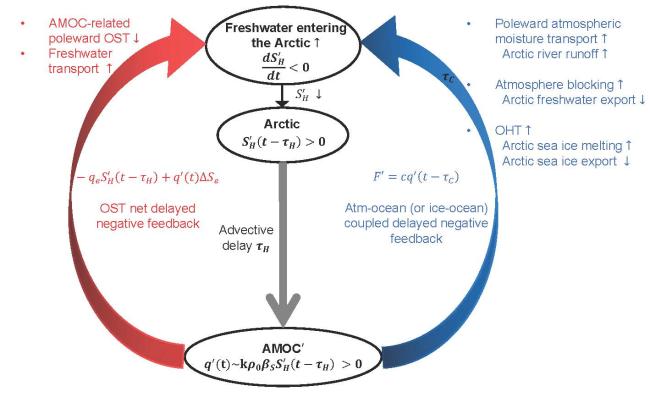A simple conceptual model for the multidecadal AMOC variability and associated two-way interactions with the Arctic salinity anomaly
The Atlantic Meridional Overturning Circulation (AMOC) plays a key role in climate. Multidecadal AMOC variability has been reconstructed through various observed AMOC fingerprints, simulated in climate models, and linked to multidecadal Arctic salinity variability. The simulated low-frequency AMOC variability often has different periods (from multidecadal to centennial) in different climate models. It is unclear what physical processes and feedbacks in these climate models influence the different periods of the AMOC variability. Unlike the inter-annual El Niño-Southern Oscillation (ENSO) that has been explained through simple conceptual models, the mechanisms of the multidecadal AMOC variability and its two-way interactions with the Arctic salinity anomaly, as well as the factors affecting the periods and amplitudes of the multidecadal AMOC variability are not well understood from the theoretical perspective using simple conceptual models. Stommel’s Two-Box Model provides a pioneering and powerful theoretical framework to study the mechanisms of steady AMOC states and abrupt AMOC changes. However, Stommel’s Two-Box Model itself does not include a self-sustained multidecadal AMOC oscillation solution.

Schematic diagram of the AMOC delayed oscillator, i.e., the delayed feedback of the revised Stommel’s Two-Box Model. A positive Arctic salinity anomaly takes an advective time delay
In a recent study authored by Wei and Zhang, Stommel’s Two-Box model is revised to include the oceanic advective time delay for the Arctic density/salinity anomaly to reach the subpolar North Atlantic and the dependence of the anomalous freshwater flux entering the Arctic on the AMOC anomaly. The revised Stommel’s Two-Box Model, calibrated by the Overturning in the Subpolar North Atlantic Program (OSNAP) observations under modern climate, is able to illustrate the AMOC delayed oscillator mechanism at multidecadal timescales and suggests an important role of the Arctic salinity anomaly and associated delayed negative feedback in multidecadal AMOC variability. The regimes and multidecadal periods of the AMOC delayed oscillator depend crucially on the advective time scale of the Arctic signal reaching the subpolar North Atlantic. The AMOC-related coupled freshwater feedback provides additional delayed negative feedback and reduces the threshold of the advective time delay needed for the multidecadal AMOC oscillations. Previous studies identified the tropical Pacific oceanic wave propagation as a key delay mechanism for the inter-annual ENSO delayed oscillator. Here for the multidecadal AMOC delayed oscillator, it is the oceanic advection of the salinity anomaly from the Arctic to the subpolar North Atlantic that provides a key delay mechanism.
The conceptual model is constructed to be as simple as possible and provides a novel theoretical framework/perspective to understand the mechanisms of reconstructed and simulated multidecadal AMOC variability, its two-way interactions with the Arctic salinity variability, and the different variability periods simulated in climate models. Climate models often underestimate the amplitude of multidecadal AMOC variability, which might be related to the underestimated Arctic salinity anomalies in climate models. Recent observations show significant negative salinity anomalies in the Arctic. Monitoring the potential downstream propagations of Arctic salinity anomalies would be valuable for predicting the timing and amplitude of future AMOC changes.
A Simple Conceptual Model for the Self-Sustained Multidecadal AMOC Variability (Geophysical Research Letters)
Topics
- AMOC
- Atlantic Ocean
- Arctic
- Internal Variability
